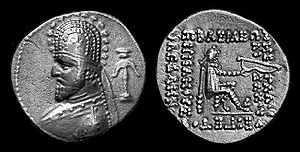
Sanatruces of Parthia
Encyclopedia

Parthia
Parthia is a region of north-eastern Iran, best known for having been the political and cultural base of the Arsacid dynasty, rulers of the Parthian Empire....
from c. 77 to c. 70 BC. He was a member of the Arsacid house, who, according to work attributed to Lucian
Lucian
Lucian of Samosata was a rhetorician and satirist who wrote in the Greek language. He is noted for his witty and scoffing nature.His ethnicity is disputed and is attributed as Assyrian according to Frye and Parpola, and Syrian according to Joseph....
, in the troubled times after the death of Mithridates II
Mithridates II of Parthia
Mithridates II the Great was king of Parthian Empire from 123 to 88 BC. His name invokes the protection of Mithra. He adopted the title Epiphanes, "god manifest" and introduced new designs on his extensive coinage....
in ca. 88 BC was made king by the Sacaraucae Scythians or Saka, an Indo-European
Proto-Indo-Europeans
The Proto-Indo-Europeans were the speakers of the Proto-Indo-European language , a reconstructed prehistoric language of Eurasia.Knowledge of them comes chiefly from the linguistic reconstruction, along with material evidence from archaeology and archaeogenetics...
tribe akin to the Parthians who had invaded Iran
Iran
Iran , officially the Islamic Republic of Iran , is a country in Southern and Western Asia. The name "Iran" has been in use natively since the Sassanian era and came into use internationally in 1935, before which the country was known to the Western world as Persia...
in about 77 BC.
- "Sinatroces, king of Parthia, was restored to his country in his eightieth year by the Sacauracian Scyths, assumed the throne and held it seven years." Makrobioi, 15.
He died circa 70 BCE and was succeeded by his son Phraates III
Phraates III of Parthia
King Phraates III of Parthia succeeded his father Sanatruces and ruled the Parthian Empire from 70 to 57 BC. He was called "the God" because of his coins, that were ideal for sailors because they were polished with gold dust, so that people from other countries considered their value higher than...
.
Sanatruces in Byzantine tradition
Another SanatrucesSanatruces II of Parthia
Sanatruces II of Parthia, the son of Mithridates IV, was a pretender to the throne of the Parthian Empire during the disputed reign of his uncle Osroes I....
(Sanatrucius), the son of Mithridates IV
Mithridates IV of Parthia
Mithridates IV of Parthia ruled the western Parthian Empire from 129 to 140. He was the brother of Osroes I of Parthia . He was the youngest son of the Parthian King Vonones II. During the invasion of Mesopotamia by the Roman emperor Trajan in 116 he and his son Sanatruces II took up the diadem...
is mentioned as an ephemeral Parthian king in AD 115
115
Year 115 was a common year starting on Monday of the Julian calendar. At the time, it was known as the Year of the Consulship of Messalla and Vergilianus...
by John Malalas
John Malalas
John Malalas or Ioannes Malalas was a Greek chronicler from Antioch. Malalas is probably a Syriac word for "rhetor", "orator"; it is first applied to him by John of Damascus .-Life:Malalas was educated in Antioch, and probably was a jurist there, but moved to...
, in his Chronographia.

